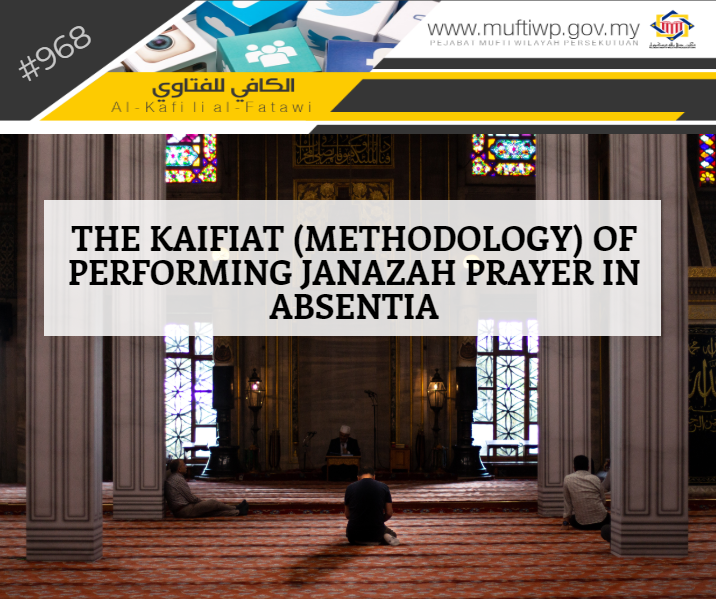Question:
Assalamualaikum wrm.wbt.,
Can you explain the kaifiat of performing janazah prayer in absentia?
Answer:
Waalaikumussalam wrm. wbt.,
Alhamdulillah, praise and thanks to Allah for the countless blessings He has blessed us all with. Blessings and salutations to the Prophet Muhammad PBUH, his wives, his family, companions and all those that follow his teachings to the day of judgement.
Janazah prayer in absentia means the prayer is performed in another state which is far from his state of origin. (Refer al-Taqrirat al-Sadidah, pg. 385). The sanctioning of performing janazah prayer in absentia is in accordance with a hadith narrated by Abu Hurairah RA:
أَنَّ رَسُولَ اللَّهِ صلى الله عليه وسلم نَعَى النَّجَاشِيَّ فِي الْيَوْمِ الَّذِي مَاتَ فِيهِ، خَرَجَ إِلَى الْمُصَلَّى، فَصَفَّ بِهِمْ وَكَبَّرَ أَرْبَعًا
Allah's Messenger (ﷺ) informed (the people) about the death of An-Najashi on the very day he died. He went towards the Musalla (praying place) and the people stood behind him in rows. He said four Takbirs (i.e. offered the Funeral prayer).
Sahih al-Bukhari (1245) and Sahih Muslim (951)
The Time for Janazah Prayer in Absentia
According to Ibn Hajar al-Asqalani, janazah prayer in absentia is permissible to be performed as soon as the news of the death and continues for three days. The reason is three days is the duration of time for offering condolences according to fiqh books. However, the final opinion states that it is permissible to perform the janazah prayer in absentia as long as he is from people of prayer when the death took place. (Refer al-Tanbih pg. 38, al-Umm 1/244 dan Mughni al-Muhtaj,1/346)
Among the conditions of janazah prayer are:
- The janazah prayer in absentia is performed in a state where it is different from where the deceased is.
- The janazah prayer in absentia is performed after the deceased is bathed.
(Refer al-Taqrirat al-Sadidah, pg. 385 and al-Fiqh al-Manhaji, 1/600)
Kaifiat of Janazah Prayer in Absentia
It is performed the same way as the normal janazah prayer.
First: Takbiratul ihram with the intention of janazah prayer. An example of the intention is: “I’m performing this fardhu janazah prayer for Allah Taala.”
Second: After takbir, place both hands on one’s chest like in normal prayer and recite the Fatihah. This is in accordance with a hadith narrated by Talhah bin Abdullah bin ‘Auf as the following:
صَلَّيْتُ خَلْفَ ابْنِ عَبَّاسٍ رَضِىَ اللهُ عَنْهُمَا عَلَى جَنَازَةٍ فَقَرَأَ بِفَاتِحَةِ الْكِتَابِ قَالَ لِيَعْلَمُوا أَنَّهَا سُنَّةٌ
I offered the funeral prayer behind Ibn `Abbas and he recited Al-Fatiha and said, "You should know that it (i.e. recitation of Al-Fatiha) is the tradition of the Prophet (ﷺ) Muhammad.”
Sahih al-Bukhari (1335)
Third: After reciting al-Fatihah, recite the second takbir whilst raising both hands up to the ears, then place them back on the chest and recite any blessings and salutations for the Prophet PBUH. The prioritized salutations are the Abrahamic salutations as stated in the chapter on the rulings in prayer.
Fourth: Perform the third takbir and this is followed by a supplication for the deceased. Supplicating for the deceased is the main purpose of the janazah prayer. This is explained in a hadith narrated by Umamah bin Sahal RA:
أَنَّهُ أَخْبَرَهُ رَجُلٌ مِنْ أَصْخَابِ النَّبِيِّ أَنَّ السُّنَةَ فِي الصَّلاَةِ عَلَى الجَنَاَزَةِ أَنْ يُكَبِّرَ الإِمَامُ، ثُمَّ يَقْرَأُ بِفَاتِحَةِ الْكِتَابِ بَعْدَ التَكْبِيْرَةِ الأُوْلَى سِرًّا فِي نَفْسِهِ ثُمَّ يُصَلِّى عَلَى النَّبِيِّ وَيُخَلِّصَ الدُّعَاءَ لِلْجَنَازَةِ فِي التَكْبِيْرَاتِ وَلاَ يَقْرَأَ فِي شَيْءٍ مِنْهُنَّ ثُمَّ يُسَلِّمَ سِرًّا فِي نَفْسِهِ
“he was told by a man from among the companion of the Prophet PBUH that the janazah prayer according to the sunnah is the imam will perform the takbir, recite the Fatihah in a low voice, followed by only blessings and salutations for the Prophet PBUH and supplication for the deceased without any other recitations. Afterwards, the salam is said in a low voice.”
Narrated by al-Baihaqi in Sunan al-Kubra (4/39)
Likewise, at the very least the supplication should be:
اللَّهُمَّ ارْحَمهُ أوِ اغْفِرلَه
“O Allah! Bless him or O Allah! Forgive him.” (Refer al-Fiqh al-Manhaji, 1/602)
Fifth: Perform the fourth takbir, then supplicate:
اللَّهُمَّ لاَ تَحْرِمْنَا أَجْرَهُ وَلاَ تَفْتِنَّا وَاغْفِرْ لَنَا وَلَهُ
“O Allah! Don’t stop his rewards from us, protect us from fitnah after his death and forgive us and him.”
Sunan Abu Daud (3201)
Sixth: Give salam twice, one to the right and another to the left just like in other prayers.
Conclusion
To conclude, janazah prayer in absentia is permissible to be performed at any time after the deceased is bathed. The condition is it must be performed in another state from where the deceased is. While the kaifiat for it is practically the same as janazah prayer while standing without rukuk (bowing in prayer), sujud (prostration in prayer) and sitting.
Wallahua’lam.


